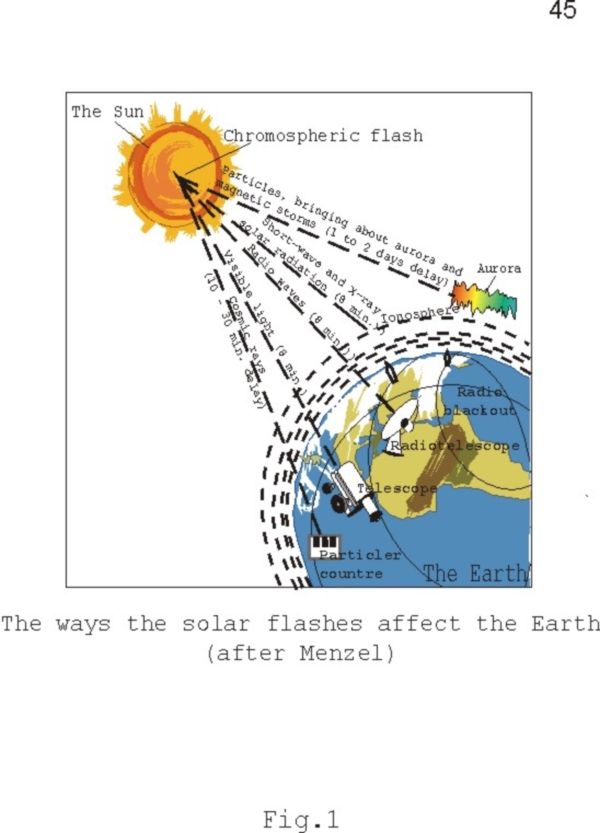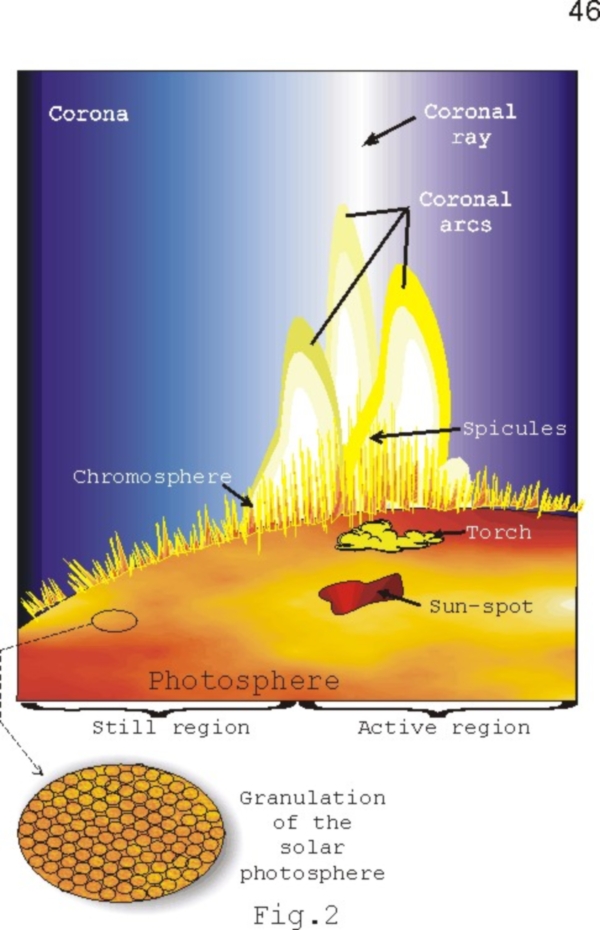Chapter 1. introduction and review of the solar
problems.
The author suggests quantum theory of the processes
occurring on the Sun and the starts, which accounts for nearly all solar
processes, does not conflict with any fundamental law of physics and brings
about radical change in our present insight into the universe.
But first, the author would like to introduce the present-day knowledge of astrophysicists of various solar problems.
The Sun is an ordinary star of our Galaxy. For the earthly viewer, the unique nature of the Sun consists in the fact that it is the nearest to us and, for the present, the only star, whose surface may be subject to detailed exploration. The Sun – is a gaseous or, to be more prices, plasmas sphere. The radius of the Sun is 6.96*1010 cm. The mass of the Sun is 1.99*1033 g. The average period of rotation for the Sun is 25.38 days. Radiation power of the Sun, i.e., its existence, is 3.86*1033erg/sec. or 3.86 *1026W. The surface temperature of the Sun determined the theoretically is 6.000K.
The surface of the Sun is characterised by a granular structure, granularity. Granules are bright spots of rather a round form visible on the Sun image in the white light. the size of the granules varies in the range of 150 to1.000
km , their lifetime is 5 – 10 min. Granules can be seen
as round and light objects, surrounded by dark intervals. Astrophysicists
estimated the temperature of light object. Solar granularity is explained by
convective motion of the surface layers of the Sun, however, the causes
underlying this process are not reported.
But first, the author would like to introduce the present-day knowledge of astrophysicists of various solar problems.
The Sun is an ordinary star of our Galaxy. For the earthly viewer, the unique nature of the Sun consists in the fact that it is the nearest to us and, for the present, the only star, whose surface may be subject to detailed exploration. The Sun – is a gaseous or, to be more prices, plasmas sphere. The radius of the Sun is 6.96*1010 cm. The mass of the Sun is 1.99*1033 g. The average period of rotation for the Sun is 25.38 days. Radiation power of the Sun, i.e., its existence, is 3.86*1033erg/sec. or 3.86 *1026W. The surface temperature of the Sun determined the theoretically is 6.000K.
The surface of the Sun is characterised by a granular structure, granularity. Granules are bright spots of rather a round form visible on the Sun image in the white light. the size of the granules varies in the range of 150 to
Sun-spots are often visible on the solar surface /photosphere/.
Sun-spots are dark objects, consisting, as a rule, of a darker nucleus (the
shadow) and a lighter half-shadow, which surrounds it. The diameter of the
sun-spots differs from several thousand kilometres to more than one hundred
thousand kilometres. The lifetime of the sum-spots is from several hours to
several month. From comparison of line intensities and continuous spectrum of
the spots and photosphere it follows that the spots are one-to-two thousand
degrees colder than the photosphere. All the sun-spots have a strong magnetic
field reaching the strength level of 5.000 oersted. The spots usually form the
groups, which are always surrounded by torches and solar prominences. Solar
flashes sometimes occur in the vicinity of groups of the sun-spots, and the
formation of ray-like objects ( helmets, large fans) is observed in the solar
corona above them. All these together form the active region of the Sun. X-ray
photograph of the Sun depicts the Sun-spots as bright objects against the
generally dark background. The sun-spots are hollows in the photosphere.
Options differ as to the estimation of the sun-spots depth, but in general, the
value of these thousand kilometres is reported. The nature of their formation
is the aspect of controversy among astrophysicists. Hitherto, not a single
theory of the sun-spots formation has been unanimously approved. Formation of a light (in the rays of optical range)
object, called the torch, precedes the appearance of the sun-spots in this
region of the atmosphere of the Sun. The occurrence of the sun-spots is
accompanied by strong flashes in the atmosphere of the Sun, which are observed
in the rays of the optical range and the light of the chromospheric lines. The
effect of the solar flashes upon the Earth takes the form of increase in the
flux of the solar particles, of magnetic storms, of aurora, of radio blackouts,
etc. (See Fig. 1).

The luminance of the solar disc decreases from the centre to the edge, and the level of this decrease is dependent on the wavelength, so that, e.g. , the luminance at the edge of the solar disc for the light with a wavelength of3,000
A is about 0,2 of that in its centre, and for 5,000 A – of about 0,3 of
the solar disc luminance. At the very edge of the solar disc the luminance
decreases 100 times within less than one second of the ars, hence, the boundary
of the solar disc is very well defined. This phenomenon was called "darkening
towards the edge”.

The luminance of the solar disc decreases from the centre to the edge, and the level of this decrease is dependent on the wavelength, so that, e.g. , the luminance at the edge of the solar disc for the light with a wavelength of
Numerous solar processes of interest take place in the
atmosphere of the Sun. The solar atmosphere is conventionally subdivided into
two Layers. The closest layers to the solar surface is called chromosphere, the
remotest Layer – solar corona.
Solar activity is most intense in chromosphere – light sphere with a reddish tint , well observed at the time , which immediately precedes the moment , when Sun is hidden behind the Moon completely . It is in chromosphere that the above mentioned solar prominences , torches and flashes are observed in their diversity . One of the most remarkable and beautiful phenomena , which occurs in chromosphere , are the spicules . Spicules are the streams of matter , rising upwards with speeds of 20 – 30 km/sec to the height of more than 6 ,

Solar corona is considerably simpler in structure than chromosphere and photosphere. The corona is especially bright close to the Sun, and long rays extend for large distances. The specific feature of the corona is its extremely high temperature, about two million degrees on the average . Above the sun – spots , the corona temperature reaches one hundred million degrees . It is but natural to ask a question : why is the solar corona heated so heavily? This is what Mookhin L. M. , Doctor of Physical and Mathematical Sciences , wrote in this connection in his book " Astronomy World” ( page 205 ):
"The nature of solar flashes , prominences, sun-spots will be clear only at the time, when the mechanism , leading to the emergence of magnetic fields on the Sun is completely studied. At present, there is no conventional theory of all these phenomena. That is why we do not understand, in particular, what the sun – spot stability is provided by; what the corona heating process Iooks like, etc.”
And what processes take place in the entrails of Sun? According to the modern judgements of astrophysicists, thermonuclear reactions take place in the entrails of the Sun, in the course of which hydrogen is combustible. Hydrogen burning turns it into helium with the thermonuclear energy release , at the expense of which the Sun shines . The temperature of the solar entrails is supposed to be about sixteen million degrees. But in the theory of thermonuclear processes, taking place in the entrails of the Sun, not everything is clear to the astrophysicists as well. The thing is that these reactions should be accompanied by release of a huge number of elementary particles, neutrino. But when the well – known American astrophysicist – experimenter Davis R. Of Brukehaven National Laboratory – designed his solar neutrino detector and this device didn't manage to discover solar neutrino for many years, the crisis of confidence appeared concerning the basic theories of Stella constitution and evolution. One of the leading modern astrophysicists Cameron A. Says that it is the problem of solar neutrino that serves as a warning about the necessity of being careful, when asserting that we have already gained an understanding of the nature of the solar entrails and the other stars.